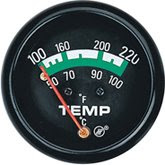Another car problem? Oh, is it your engine's temperature gauge this time? Not to worry, we'll discuss few troubleshooting ways to repair this automotive gauge. You must ensure that the auto gauges function properly so as to avoid any kind of damage to the vehicle's engine. There are different types of auto gauges like fuel gauge, temperature gauge, tire pressure gauge and many more.
Temperature gauge in the vehicle is installed to indicate the temperature range within which the engine is working. It is very essential that we maintain these car parts and speaking honestly, its not actually difficult to do so because problems with auto gauges can be easily diagnosed. Few small checks of these auto gauges will help you know whether you need to replace them with new temperature gauges.
Begin with the Gauge Wire. Unplug it at the sending unit. Remember, you must unplug only the temperature gauge wire. Usually, you will find the wire located on the engine.
Turn on the Ignition Key. Please ensure that you don't have to start the engine of the vehicle.
Ground this Wire to Engine. The next step that follows is of grounding the temperature gauge wire to engine. You can do this by using a jumper wire.
 Keep an eye on the Temperature Gauge Needle. Check what does it indicate. If it reads 'Hot', it is time to replace the temperature sending unit.
Keep an eye on the Temperature Gauge Needle. Check what does it indicate. If it reads 'Hot', it is time to replace the temperature sending unit.If Needle does not read 'Hot' – In such a case, you should check the fuse whether it is fine.
Fixing the Problem - Now that you have ensured that you fuse is working fine, check the voltage. For that you need a voltmeter. You must check the voltage at ignition terminal using this voltmeter.
Found a Problem there? - You might notice that there is no voltage. If this is the case, then it is because of some damage in the circuit between the ignition key & gauge or fuse panel & gauge temperature.
Repair It – Since you have diagnosed this problem, repair or fix it. Fix the problem and test again. You may also replace the gauge.
Observe Closely – Ground the temperature gauge wire to engine with a jumper wire. Check the gauge. If its working fine, then disconnect the wire at sending unit as well as turn on the ignition.
Needle Higher then Cold Range – Does the needle this time indicate that it is a
 little bit higher than cold range. If it is, then unplug the wire that is going to the sending unit at the gauge. Check the gauge again by turning on the ignition key.
little bit higher than cold range. If it is, then unplug the wire that is going to the sending unit at the gauge. Check the gauge again by turning on the ignition key.Watch the Needle this Time – Is it still higher than cold range, the gauge needs to be changed. Check the auto gauge, doesn't it read 'Cold'.
Gauge Reads 'Cold' – You can fix this problem of short in the wiring. It is because of this, the gauge reads cold. After the repair, test the gauge again.
These were some of the ways how you test your temperature gauge of your vehicle. Monthly checks of the automotive gauges will help you avoid any major damage of the engine. In case, you are stuck anywhere, I suggest do not take a chance. Call your car repair mechanic. Try these troubleshooting tips and have a safe driving experience. Happy Driving.




1 comments:
The minimum number of gauges on a passenger car dashboard are the speedometer and the fuel gauge. The most common additional gauge is the temperature gauge followed by the tachometer, voltmeter and oil pressure gauge.
Post a Comment